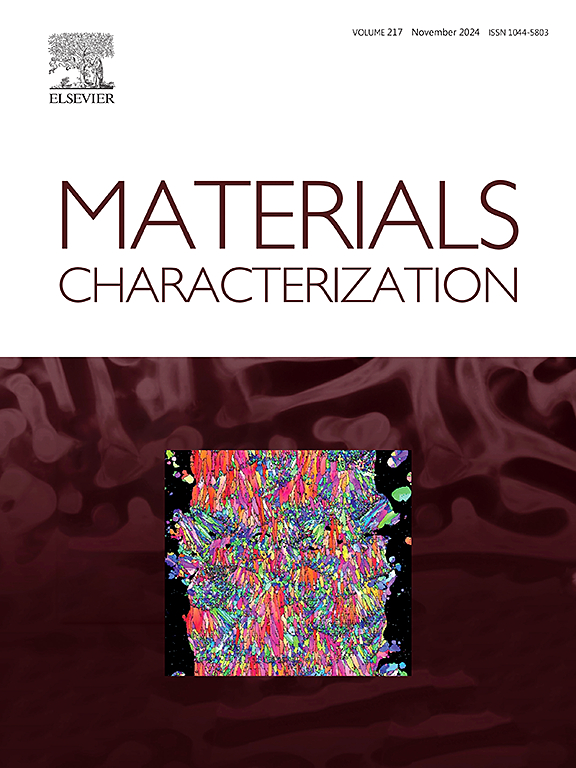Deformation coordination behaviors and microstructure evolution of 1060Al/6061Al-SiC/1060Al composites during hot deformation
IF 5.5
2区 材料科学
Q1 MATERIALS SCIENCE, CHARACTERIZATION & TESTING
引用次数: 0
Abstract
The hot deformation behavior and microstructure evolution of 1060Al/6061Al-SiC/1060Al laminated particle-reinforced aluminum matrix composites (LPRAMCs) under different process parameters and the deformation coordination between the component layers were investigated by hot-compression technology. The deformation of the LPRAMCs was dominated by work-hardening as exhibited by the flow stress curves, and stress decrease occurred at high strain rate (20 s−1) when the strain was greater than 0.8 due to the deformation incoordination between the SiC particles and the Al matrix. The deformation in the central region of the composite after compression was dominated by the SiC-reinforced 6061Al layer (CS layer). In contrast, the deformation at the edge was primarily governed by the 1060Al layer (Al layer), and the optimal deformation coordination was achieved under the high-temperature/low-strain-rate region (400–500 °C/0.01–1 s−1). The microstructural evolution indicated that 1060Al has equiaxed fine grains near the interface and coarse grains away from the interface, the recrystallization of 6061Al in the CS layer occurred earlier than that of 1060Al in the Al layer, and the grain size (GS) of 6061Al was less affected by the deformation parameters due to the SiC particles in the CS layer. With the increase of lnZ, the recrystallized proportion of Al grains in the Al layer and CS layer decreased gradually.
1060Al/6061Al-SiC/1060Al复合材料热变形过程中的变形配位行为及显微组织演变
采用热压缩技术研究了1060Al/6061Al-SiC/1060Al层状颗粒增强铝基复合材料(LPRAMCs)在不同工艺参数下的热变形行为和微观组织演变以及各组分层间的变形协调。流变应力曲线表明,LPRAMCs的变形以加工硬化为主,当应变大于0.8时,由于SiC颗粒与Al基体之间的变形不协调,在高应变速率(20 s−1)下应力降低。压缩后复合材料中心区域的变形以sic增强6061Al层(CS层)为主。边缘变形主要受1060Al层(Al层)控制,在高温/低应变率区域(400-500℃/ 0.01-1 s−1)下实现最佳变形协调。显微组织演化表明,1060Al在界面附近具有等轴细晶和远离界面的粗晶,6061Al在CS层中的再结晶比在Al层中的再结晶发生得早,并且由于CS层中存在SiC颗粒,6061Al的晶粒尺寸(GS)受变形参数的影响较小。随着lnZ的增加,Al层和CS层中Al晶粒的再结晶比例逐渐降低。
本文章由计算机程序翻译,如有差异,请以英文原文为准。
求助全文
约1分钟内获得全文
求助全文
来源期刊

Materials Characterization
工程技术-材料科学:表征与测试
CiteScore
7.60
自引率
8.50%
发文量
746
审稿时长
36 days
期刊介绍:
Materials Characterization features original articles and state-of-the-art reviews on theoretical and practical aspects of the structure and behaviour of materials.
The Journal focuses on all characterization techniques, including all forms of microscopy (light, electron, acoustic, etc.,) and analysis (especially microanalysis and surface analytical techniques). Developments in both this wide range of techniques and their application to the quantification of the microstructure of materials are essential facets of the Journal.
The Journal provides the Materials Scientist/Engineer with up-to-date information on many types of materials with an underlying theme of explaining the behavior of materials using novel approaches. Materials covered by the journal include:
Metals & Alloys
Ceramics
Nanomaterials
Biomedical materials
Optical materials
Composites
Natural Materials.
 求助内容:
求助内容: 应助结果提醒方式:
应助结果提醒方式:


